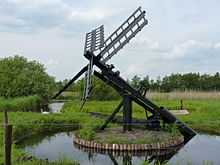Tjaskers in Overijssel
A Tjasker is a type of small drainage windmill used in the Netherlands and north Germany. There are seven tjaskers remaining in Overijssel, all located in the marshy region in the northwest corner of the province.
Locations







Giethoorn
- Molengat
52°44′31″N 6°05′04″E / 52.741814°N 6.084491°E
The paaltjasker was built in 1979 in Giethoorn and is in private ownership.[1] Its operational but has no real function. The tjasker has four Common sails, which have a span of 5.40 metres (17 ft 9 in).[2]
- Noord
52°44′35″N 6°05′03″E / 52.742984°N 6.084095°E
The paaltjasker was built in 1970 by well known tjasker builder Roelof Dijksma to drain his an his neighbours garden.[3] The tjasker has four symmetrical Common sails that can be covered with wooden slats and which have a span of 5.1 metres (16 ft 9 in).
[4][5]
- Zuid
52°43′19″N 6°05′20″E / 52.722061°N 6.088854°E
The paaltjasker was built in 1988 and is part of museum 't Olde Maat Uus showing life in Giethoorn about a century ago. The tjasker is operational but because of its sheltered location it is powered by an electric motor. It can be visited during opening hours of the museum. The tjasker has four Common sails that can be covered with wooden slats and which have a span of 5.0 metres (16 ft 5 in).[6][7]
Jonen
52°43′10″N 6°01′18″E / 52.719481°N 6.021737°E
The paaltjasker was built in 2010 on the initiative of Stichting Natuurlijk Jonen which works on the protection of the cultural and natural landscape around hamlet Jonen. The tjasker has four symmetrical Common sails that can be covered with wooden slats.[8][9]
Ossenzijl/Kalenberg
- Nameless tjasker on Hoogeweg
52°47′02″N 5°58′54″E / 52.783892°N 5.981597°E
The paaltjasker was built in 1963 by well known tjasker builder Roelof Dijksma. It was donated to Staatsbosbeheer by monthly Overijssel magazine De Mars to celebrate its 10th anniversary and was the start of a small renaissance for tjaskers in general.[10] The tjasker has four symmetrical Common sails that can be covered with wooden slats and is used to pump water into the quaking bog. .[11][12]
- Nameless tjasker on Hoogeweg near De Weerribben visitor centre
52°48′31″N 5°56′14″E / 52.808513°N 5.937158°E
The paaltjasker was built in 1977 by Jac. Punter of Paaslo as a copy of the above mentioned tjasker built by Dijksma.[10] It was repaired and moved about 200 m in 1984. The tjasker is close to the Staatsbosbeheer visitor centre of nature reserve De Weerribben near Ossenzijl and is used to pump water into the reed beds in summer. The tjasker has four symmetrical Common sails that can be covered with wooden slats and which have a span of 5.55 metres (18 ft 3 in).[13][14]
Sint Jansklooster
- De Foeke
52°40′06″N 6°00′56″E / 52.668342°N 6.015439°E
The paaltjasker was built in 1968 by well known tjasker builder Roelof Dijksma for nature conservation organisation Natuurmonumenten near their then newly built visitor centre De Foeke in nature reserve De Wieden near Sint Jansklooster. The tjasker has four symmetrical Common sails that can be covered with wooden slats and which have a span of 5.15 metres (16 ft 11 in).[15][16]
[17]
Dutch Wikipedia articles
- Molengat (tjasker)
- Noord (tjasker)
- Zuid (tjasker)
- Tjasker Jonen
- Tjasker Kalenberg
- Tjasker Ossenzijl
- De Foeke
References
- ↑ "Giethoorn Molengat te Giethoorn" (in Dutch). De Hollandsche Molen. Retrieved 6 August 2012.
- ↑ "Giethoorn, Overijssel" (in Dutch). Molendatabase. Retrieved 7 August 2012.
- ↑ Blom, L.H. (1976). De tjasker, een zeldzaam molentype (in Dutch). Zwolle: Uitgeverij Waanders. pp. p55. ISBN 90-70072-15-7.
- ↑ "Giethoorn, Overijssel" (in Dutch). Molendatabase. Retrieved 7 August 2012.
- ↑ "Tjasker Giethoorn Noord (naamloos) te Giethoorn-Noord" (in Dutch). De Hollandsche Molen. Retrieved 7 August 2012.
- ↑ "Giethoorn, Overijssel" (in Dutch). Molendatabase. Retrieved 7 August 2012.
- ↑ "Giethoorn-Zuid Museum Olde Maat Uus te Giethoorn" (in Dutch). De Hollandsche Molen. Retrieved 7 August 2012.
- ↑ "Giethoorn, Overijssel" (in Dutch). Molendatabase. Retrieved 7 August 2012.
- ↑ "Tjasker Giethoorn (buurtschap Jonen) te Giethoorn-Jonen" (in Dutch). De Hollandsche Molen. Retrieved 7 August 2012.
- ↑ 10.0 10.1 Blom, L.H. (1976). De tjasker, een zeldzaam molentype (in Dutch). Zwolle: Uitgeverij Waanders. pp. p51. ISBN 90-70072-15-7.
- ↑ "Ossenzijl / Kalenberg, Overijssel" (in Dutch). Molendatabase. Retrieved 7 August 2012.
- ↑ "Tjasker Ossenzijl/Kalenberg te Kalenberg / IJsselham" (in Dutch). De Hollandsche Molen. Retrieved 7 August 2012.
- ↑ "Ossenzijl / Kalenberg, Overijssel" (in Dutch). Molendatabase. Retrieved 7 August 2012.
- ↑ "Ossenzijl te Ossenzijl" (in Dutch). De Hollandsche Molen. Retrieved 7 August 2012.
- ↑ "OSint Jansklooster, Overijssel" (in Dutch). Molendatabase. Retrieved 7 August 2012.
- ↑ "De Foeke te Sint Jansklooster" (in Dutch). De Hollandsche Molen. Retrieved 7 August 2012.
- ↑ Blom, L.H. (1976). De tjasker, een zeldzaam molentype (in Dutch). Zwolle: Uitgeverij Waanders. pp. p53. ISBN 90-70072-15-7.
| |||||||||||||||||||||||||||||||||||||||||||||||||||||||||||||||||||||||||||||||||||||||||||||